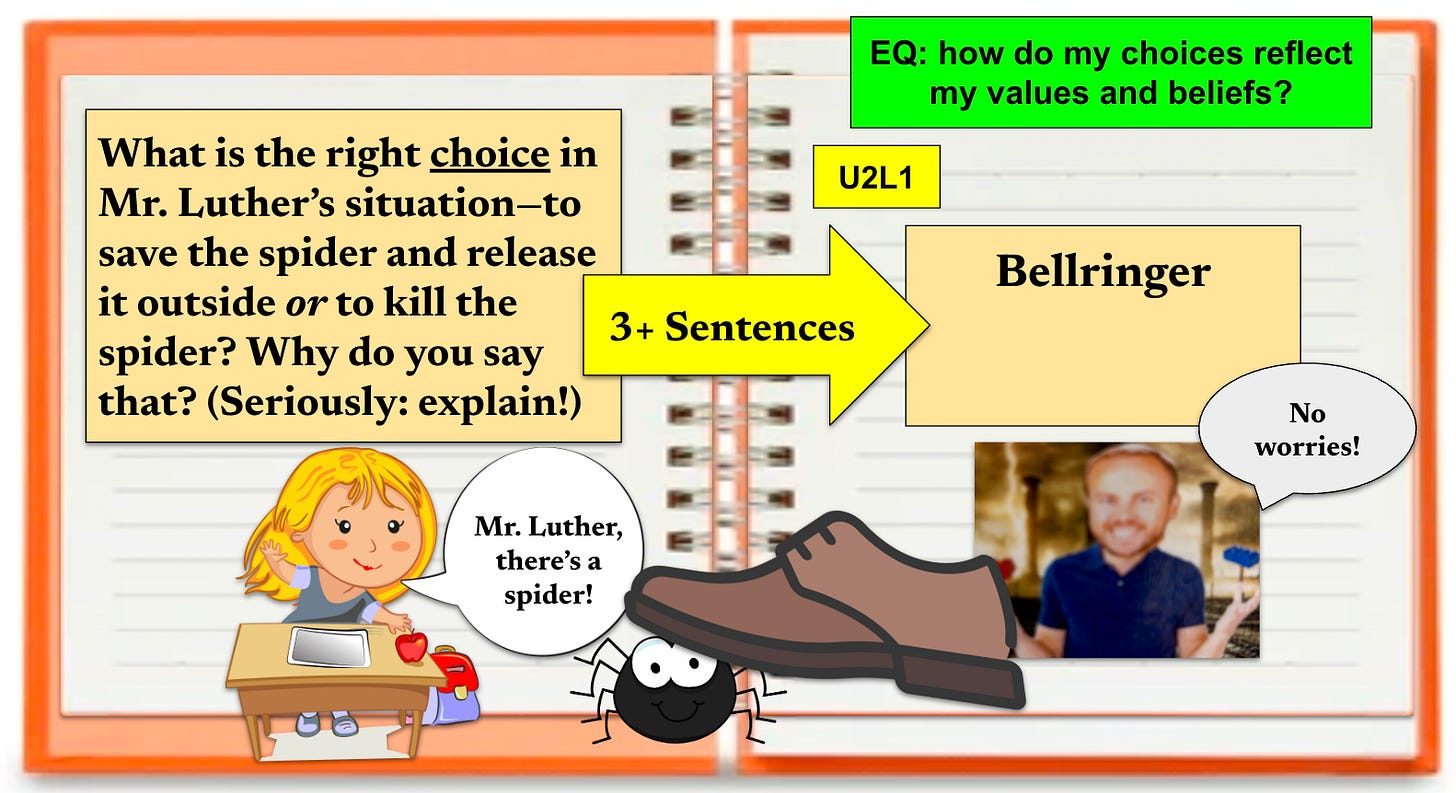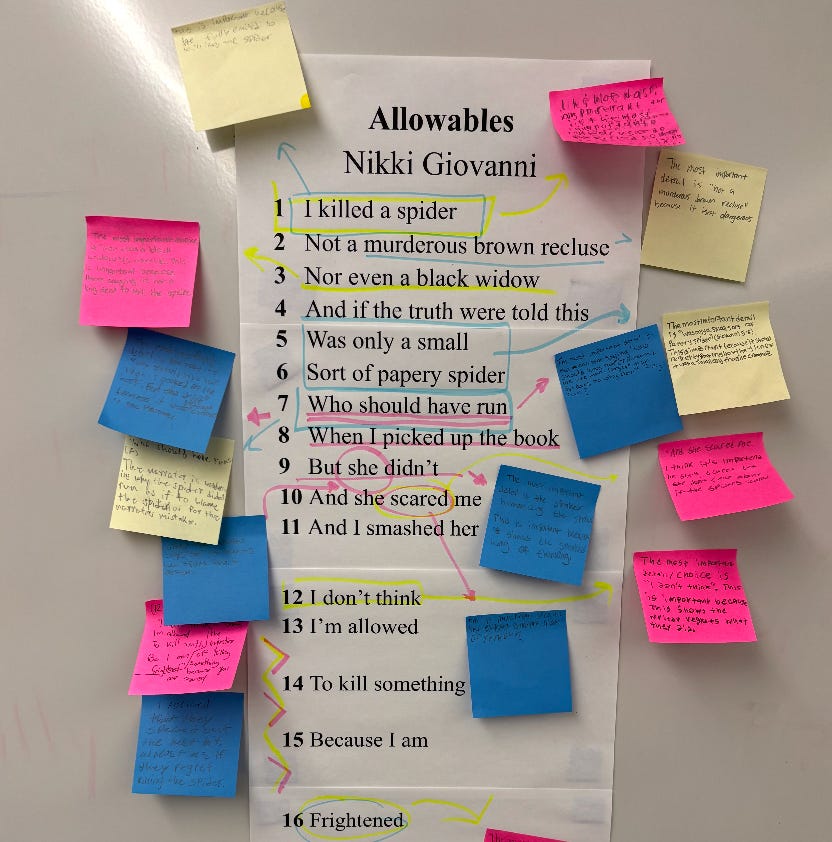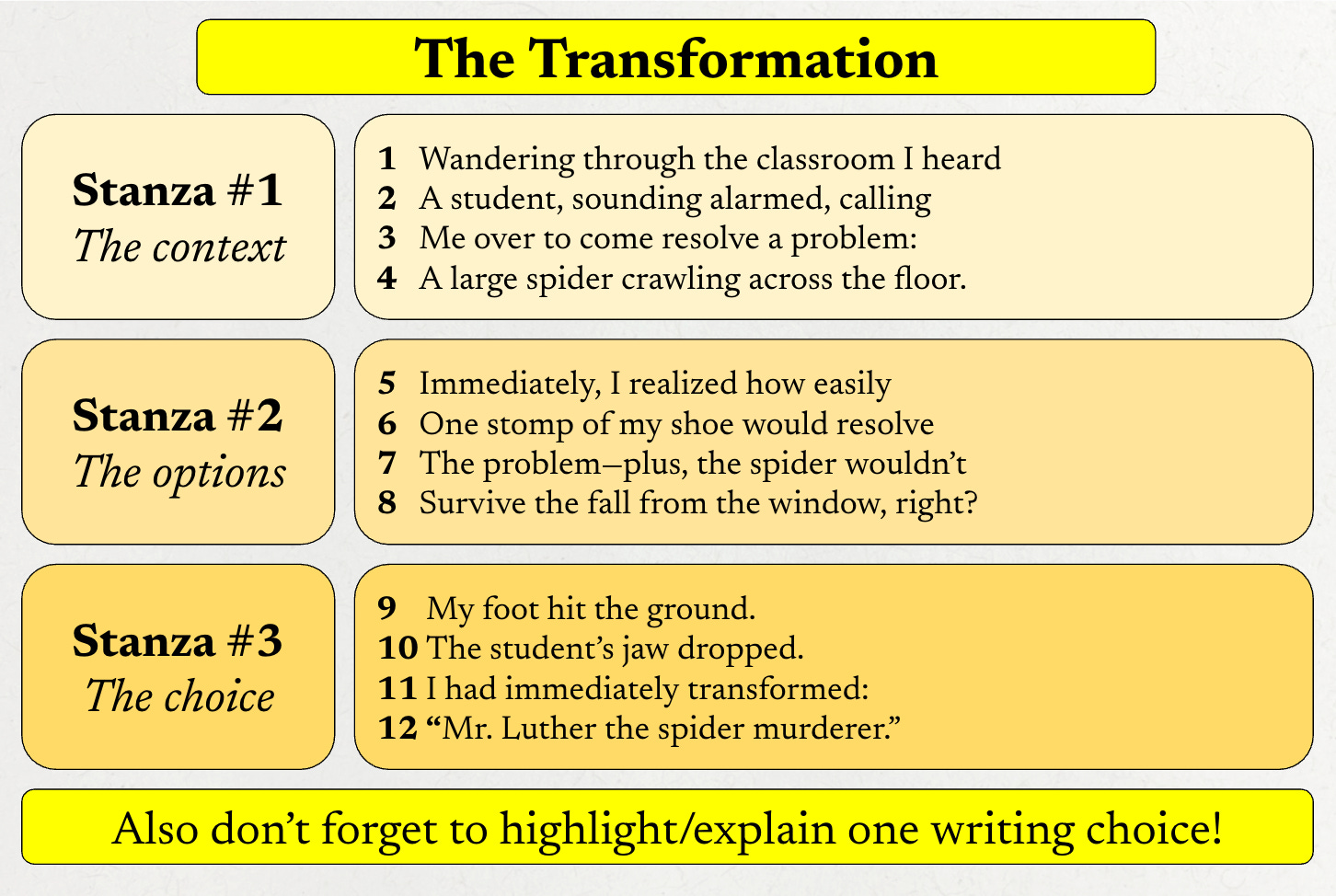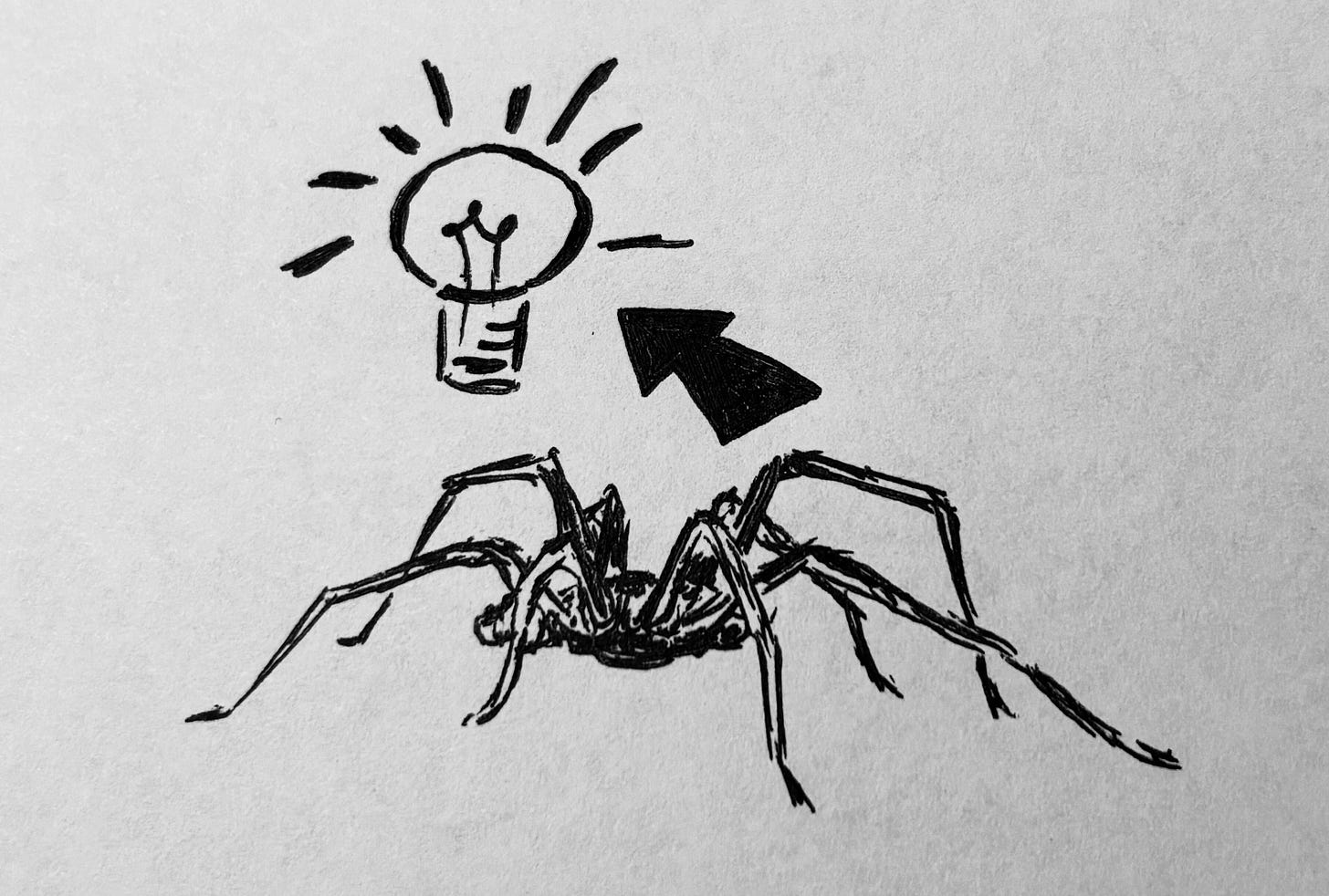A Good Lesson and an Important Lesson
and why teachers need to have agency to do what's right for their classroom
This all started with a spider.
Well, really, it started with a shout.
“Mr. Luther,” a student yelled, from the back of the room. “Spider!”
As a parent of a six-year-old and three-year-old, my immediate instinct was to eliminate the potential distraction—in this case, within a classroom of 30+ high school juniors. Rushing over, I saw them pointing at the ground.
Indeed, there was a spider.
Easy solution, right? I raised my shoe and stomped it, hoping that it would not become a larger interruption to the classroom than it already was.
The problem: as my shoe descended towards the spider, I looked up and saw the student’s face and the look of absolute horror upon it as my shoe flattened the spider’s existence.
“Mr. Luther,” they said, mouth agape. “I was going to ask you to save it and set it free out the window…”
Whoops.
To make matters worse, this was the day we had already scheduled our first home adult email of the year using ’s incredible system for students to individually update their families on how things are going in the classroom while CC’ing me on the message.
Sure enough, the following was included in this student’s email home:
I mean, to be fair, the spider wasn’t that small.
However, this spider-murdering experience was not the “good, important lesson” that resulted in today’s post.
Rather, it was the origin story for it.
🕷️ A Good Lesson, Pt. 1
Knowing that my sophomore English course was about to begin a unit on choices and the way they reveal our values and knowing that I did not at all feel good about the plans I had made for our opening week using the newly-adopted curricula for this unit, I realized that it was time to briefly pivot.
I had found a much better entry point: me.
“I have a story to tell you guys,” I began, before walking the classroom of 10th graders through the situation I had found myself in regarding the spider dilemma and the choice I had instinctively made—along with some slide deck images that I am very proud of (see above!)—before asking every single one of my sophomores to render their own verdict:
“Did Mr. Luther make the right choice?”
At this point, I used one of my staple moves in the classroom and had them all individually share out their answer. But this time, I had my handy-dandy clipboard with all my students’ names and their top values, which made for some great “content” as the sharing proceeded.
For example:
Student A: “I’d definitely kill it, no questions asked.”
Me: “Does everyone want to know Student A’s top value?”
Student A: “Oh no, Mr. Luther, don’t.”
Me: “Compassion.”
Classroom: *erupts in laughter*
Quite an opening to begin our new unit, right? A fun roast of Mr. Luther along with some entertaining, values-driven commentary that brought the classroom to life much more than any prescribed curriculum lesson would have—and then the real pivot in terms of substance:
“Okay, now let’s talk about Nikki Giovanni.”
🕷️ A Good Lesson, Pt. 2
For any English teacher reading this post, I imagine you might have guessed that this pivot was coming—just as about 5 seconds after the “spider murder” took place I realized that “Allowables” by the late, legendary Nikki Giovanni was now inevitably going to be centered in our classroom.
Here was our sequence as students moved into this poem:
I read the poem aloud multiple times. (Yes, “I killed a spider” very much had a confessional tone in my recitation.)
Students added three of their own annotations, highlighting specific details and choices along with their thinking about them.
In small groups, they had to determine their most interesting or important annotation—writing it down on a sticky note and affixing it to the larger version of the poem on the whiteboard. (The end result of this activity after three different classes with their own sticky note color is pictured above.)
From there, we moved into whole-class debriefing the message of Giovanni’s poem, and just like that a lesson that began with a random story from Mr. Luther within 30 minutes had become a reflection on the idea of unnecessary fear being a justification for lasting harm.
Talk about a needed conversation for this moment.
And to think: all of this took place because a student in another class the week before had alerted Mr. Luther about a spider on the floor—a poor spider that had no idea it was going to become a classroom legend.
💡 An Important Lesson, Too
The original reason I wanted to write about this random lesson today is because, first and foremost, I want to continue to center sharing what is good in the classroom—particularly amidst all that is difficult and frustrating as a teacher in this moment.
To be able to take a random moment and turn it into an original, engaging and purposeful lesson? One that set the foundation for a fantastic start to a unit that I had been semi-dreading?
I’m not going to lie: I was patting myself on the back more than a bit walking out of that day of teaching, as I know that a lot of creativity, expertise and hope goes into being able and willing and able to successfully pivot into something entirely new in the classroom.
Being a teacher can be a really incredible feeling.
Sometimes.
Because earlier this week, on the same day that my own spider experience had metamorphosed into a meaningful, beginning-of-unit lesson, shared an important reflection on standardization that, I’m willing to bet, resonated with a lot of teachers right now:
When I first started teaching, I had the ability to take whichever curriculum was presented to me, and make it my own. I could choose how I wanted students to engage with the required content standards. Instead of reading an excerpt from a basal reader, looking for the main idea, I could have students read novels and discuss themes, character development, and other literary elements. In the past, I had more professional agency to determine how I wanted to engage my students in the content. I could design transdisciplinary units, addressing multiple standards simultaneously. Unfortunately, this is no longer an option.
What Adrian shared about his own experience as a teacher being forced to relinquish agency and creativity in his classroom unfortunately echoes too many stories that are being shared by teachers all over the country, almost all following an all-too-familiar pattern: increased urgency around test scores; consequent purchasing of and forced alignment with new curriculum; and inevitable forfeiture of professional respect and agency for teachers in the classroom.
In Adrian’s own words:
In the push to desperately raise test scores by making every classroom the exact same, schools have lost the very essence of public education: meaningful connection through authentic teaching and learning experiences. Efficiency is replacing humanity, valuing compliance over agency.
Just what our classrooms and schools need, right? Efficiency and compliance?
💡 And an Important Question
Fortunately, for now I still have enough wiggle room in my own classroom and building to be able to pivot when I need to. To be able to imagine beyond the required texts and respond to what I’m observing firsthand in the classroom—not just the learning data but also the needs of our classroom community. (The latter of which is of course pretty much entirely left out of any curriculum mapping decisions three levels above-and-beyond the actual classroom those decisions are supposed to benefit.)
Yet while I still have that agency for now, I also can feel where the winds are blowing and recognize that, even in an incredibly supportive context, I’m having to advocate more than ever for the agency to design for the classroom that my students need and deserve.
The classroom I fell in love with 14 years ago and never looked back.
That spider in Giovanni’s poem?
A pretty haunting analogy, I think, for the agency, creativity and trust of teachers in education right now—with the metaphorical “book” (or textbook?) crashing down upon the precise things that can make the classroom a remarkable, transformative space.
To quote from the end of Giovanni’s poem, with a couple minor adaptations:
I don’t think
You’re allowed
To kill something
Because you are
Frightened.
That leads to the real question I’m sitting with, after reflecting on what it was like to read Adrian’s reflection on the exact same day I was feeling so motivated and purposeful about the “spider lesson” I had just designed from scratch:
What in the world are they so scared of?
That is the question I’m walking into the weekend with, unsure if I even want to know the answer.
Three Closing Recommendations
Once again, I want to continue the pattern of sharing three things that I found meaningful recently as a teacher:
Something to read: “When Efficiency Is Worthless” by — I genuinely appreciated this post by Josh that challenges the current lofty status word I have very much come to dislike right now as a teacher: “Often enough, the answer will be that the more efficient way is not worth taking because making it more efficient will sacrifice the essence of the thing itself.”
Something to listen to: "Faculty Perspectives on AI” from Tea For Teaching — I mean, any time you have a chance to listen to , , or individually, it is well worth your time. But when they are talking with each other around their shared values but nuanced perspectives on AI? This is a must-listen.
Something to explore: "The Reckoning: Sora 2 and the Year We Said Enough” by — within this really thoughtful and urgent post, Nick offers an example of an “AI Literacy Plan” as a response to continuing (and troubling) developments on the AI frontier. This feels like exactly what we need right now, too: thoughtful, accessible resources to bring needed conversations into classrooms and schools. Well worth taking a look for yourself!
Finally, a somewhat-self-plug: I’ll be joining with Teachers on Fire this morning at 11am EST—cannot wait for this conversation, and you can hop on and listen here if you’re interested!
Note: featured image was drawn by yours truly while his six-year-old was working a new Lego creation. Have to lean into my own agency whenever possible, right? 😎








The creativity is just joyous. Our classrooms needs to be spaces of joy. Thanks, as always, for sharing. Look forward to your work each time.
Always love learning from you. Thanks for all you do for the community at large. Cheering you on, SB